Movie vs. Book: The 9 Wildest Changes in The Running Man You Never Saw Coming
When a story jumps from the page to the big screen, something always gets shaken up. But The Running Man takes that idea to a whole new level. Stephen King’s original novel — published under the name Richard Bachman — is dark, gritty, and brutally honest. The new 2025 movie, directed by Edgar Wright, sticks closer to the book than the older film… yet it still rewrites several major moments, characters, and motivations.
If you have ever wondered how the movie stacks up against King’s version, here are the biggest differences you will notice — from character personalities to shocking endings.

1. Ben Richards Is Way Softer in the Movie
In the 2025 film, Ben Richards comes off as a heroic, thoughtful guy who tries to protect people whenever he can. He still fights, but he feels more like a character you want to root for.
The book paints a rougher picture. Richards isn’t evil, but he’s sharp-tongued, angry, and openly rude. He insults people out of frustration, and he carries the bitter edge of a man pushed too far.
The movie cleans him up for today’s audience and turns him into a more symbolic, hopeful figure.
2. Movie Ben Avoids Killing… Mostly
The film makes it clear that Richards doesn’t want unnecessary blood on his hands. He only kills the Hunters when he has no choice.
Book-Richards is much more lethal. His largest kill count happens when he detonates an explosion at a YMCA, killing several officers on purpose.
In the movie, that same explosion is caused accidentally when officers fire at him — and he’s blamed for it.
3. Sheila’s Story Gets a Softer Rewrite
In the movie, Richards gets furious when people claim his wife Sheila is a sex worker. She isn’t — she’s a waitress, and gossip twists her reputation.
But in the original novel, Sheila tells Richards she did turn to sex work to support their daughter. The book leans into the harshness of poverty, while the film tones it down for a wider audience.
4. Richards Has a Nightmare About a Different Friend
Early in the movie, Richards dreams about his friend Molie Jernigan being tortured by the Hunters. Molie is close to the family, and Richards later references this nightmare during a confrontation.
In the book, that nightmare belongs to a different character — Bradley Throckmorton, a rebel who helps Richards escape north.
Both scenes show Richards’ guilt, but the movie gives Molie a deeper connection to him.
5. The Derry Connection Is Completely Reimagined
Both versions nod to Derry, a well-known town in the Stephen King universe.
In the book, Richards reaches Derry to find a plane.
In the movie, Derry becomes the hometown of Elton Perrakis and his family. The town has been crushed by the Corporation, with forests replaced by housing projects.
It’s a recognizable name with a very different meaning.
6. Elton Perrakis Gets a Full Makeover
Elton supports Richards in both versions, but their personalities differ wildly.
- Book Elton: Overweight, passive, unable to fight.
- Movie Elton: Lean, angry, and ready to rebel. He wants revenge for his father’s death and stands beside Richards until the end.
The film pushes Elton into the role of a rebel fighter to strengthen the revolution storyline.
7. McCone’s Backstory Is Totally Different
McCone leads the Hunters in both versions, but the movie rewrites his entire past.
- Book McCone: A pretentious, overhyped hunter who hardly shows up.
- Movie McCone: A former Running Man contestant who now hunts new contestants. He’s hands-on, dangerous, and directly responsible for major deaths — including Elton’s.
The movie makes him a full antagonist instead of a distant name.
8. The Novel Gives Richards a Tragic Loss
Both stories mention Richards’ wife and daughter, but their fates are not the same.
- Book: They are actually murdered by intruders soon after Richards disappears.
- Movie: Killian lies and claims McCone’s men killed them — only for Richards to later discover his family is alive.
The movie chooses hope. The book chooses heartbreak.
9. The Endings Lead to Two Different Revolutions
The finale splits the story into two very different worlds.
- Book Ending: A dying Richards crashes a plane into the FreeVee building, killing Killian and many others. The uprising is hinted at but small.
- Movie Ending: Killian remotely tries to crash the plane to frame Richards, but it’s shot down first. The black box recording exposes Killian’s lies, the public rises up, and the resistance — led by Richards — takes down the system.
The film ends with a public victory, while the book ends with personal sacrifice.


